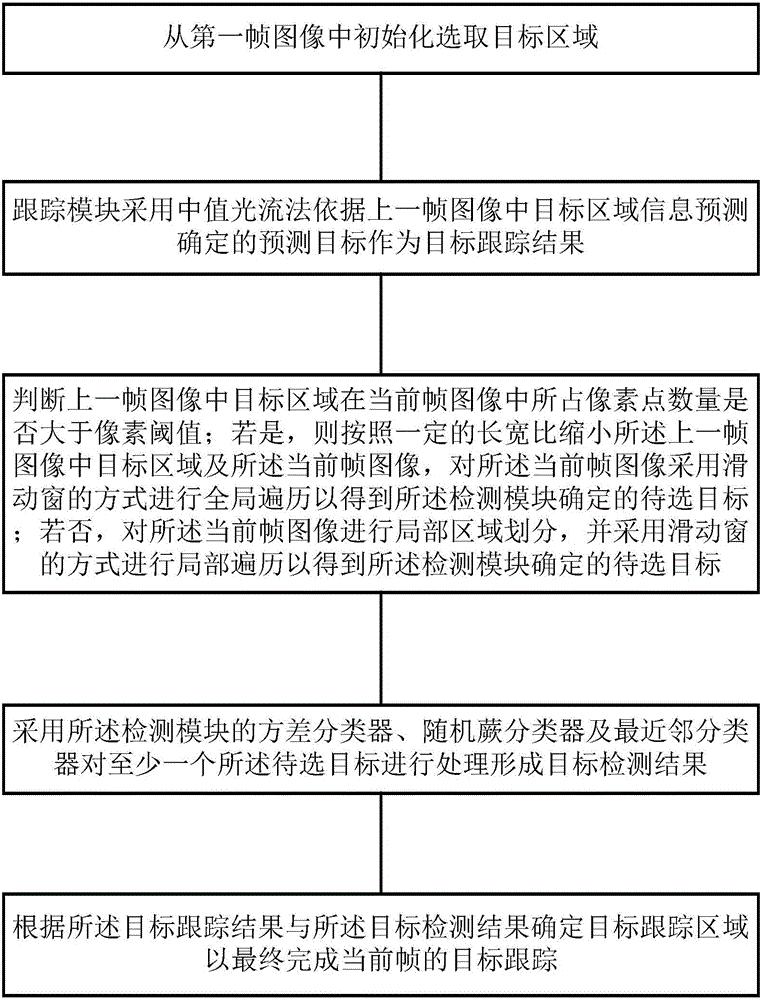Target tracking method based on TLD (Tracking-Learning-Detection) algorithm
A target tracking and target technology, which is applied in the field of target tracking, can solve problems such as easy failure of tracking, inaccurate prediction results, narrowing of TLD algorithm detection area, etc., and achieve the effect of improving real-time performance and improving real-time performance
- Summary
- Abstract
- Description
- Claims
- Application Information
AI Technical Summary
Problems solved by technology
Method used
Image
Examples
Embodiment 1
[0047] See figure 1 , figure 1 It is a schematic flowchart of a TLD algorithm-based target tracking method provided by an embodiment of the present invention. Wherein, the TLD algorithm includes a tracking module, a detection module and a learning module, and the method includes the following steps:
[0048] Step a, initializing the selected target area from the first frame of image;
[0049] Step b, the tracking module uses the median optical flow method to predict and determine the predicted target based on the target area information in the previous frame image as the target tracking result;
[0050] Step c, judging whether the number of pixels occupied by the target area in the current frame image in the previous frame image is greater than the pixel threshold; if so, shrinking the target area in the previous frame image and the current frame according to a certain aspect ratio image, the current frame image is globally traversed in a sliding window manner to obtain the...
Embodiment 2
[0082] See figure 2 , figure 2 It is a schematic diagram of the working principle of a detection module based on the TLD algorithm provided by the embodiment of the present invention. This embodiment focuses on the improvement of the detection module on the basis of the above embodiments, combined with the workflow of the TLD algorithm.
[0083] The workflow of the TLD algorithm is as follows:
[0084] The first step is to select the position and size of the target in the starting frame;
[0085] At the start frame of the video (or picture sequence), manually determine a rectangle containing the target with the mouse to obtain the position and size of the target to be tracked, that is, record the target coordinates, width and height.
[0086] In the second step, the tracking module and the detection module process each frame of image respectively to obtain their respective results;
[0087] Tracking module: Use the median optical flow method to get the result of the trac...
example 1
[0132] Example 1, the initial frame and the second frame: the purpose is to obtain the target area of the second frame. Select the target position and size in the initial frame, find the same position (same size) in the second frame, set the center coordinates of this position as: (x, y) (x width direction, y height direction), and the target size is : width (width), height (height); then the area size is: upper left vertex bottom right vertex The center position is still (x,y).
PUM
 Login to View More
Login to View More Abstract
Description
Claims
Application Information
 Login to View More
Login to View More - R&D
- Intellectual Property
- Life Sciences
- Materials
- Tech Scout
- Unparalleled Data Quality
- Higher Quality Content
- 60% Fewer Hallucinations
Browse by: Latest US Patents, China's latest patents, Technical Efficacy Thesaurus, Application Domain, Technology Topic, Popular Technical Reports.
© 2025 PatSnap. All rights reserved.Legal|Privacy policy|Modern Slavery Act Transparency Statement|Sitemap|About US| Contact US: help@patsnap.com


